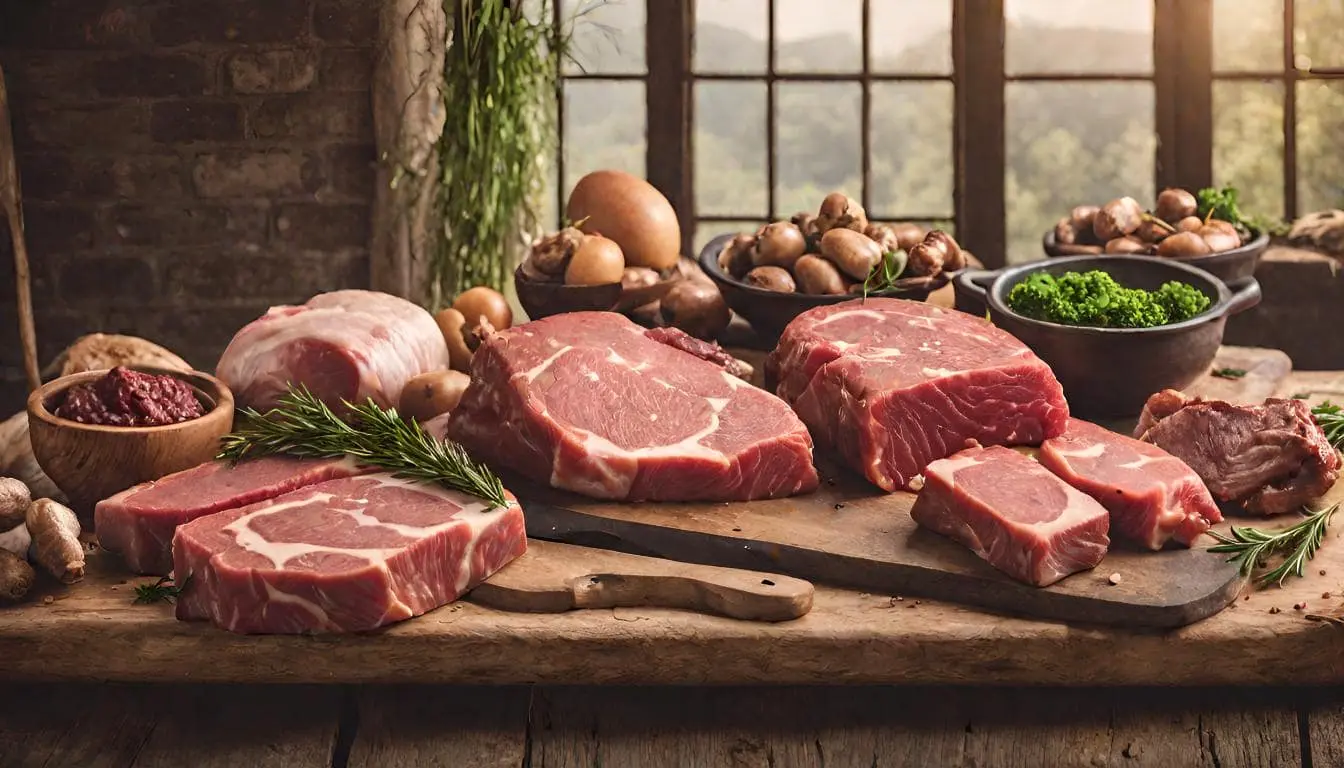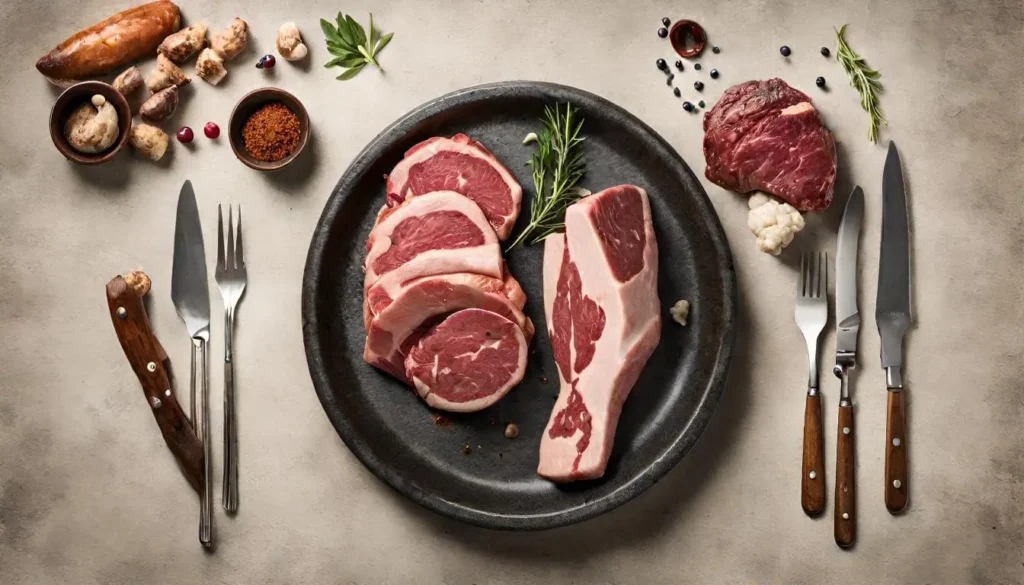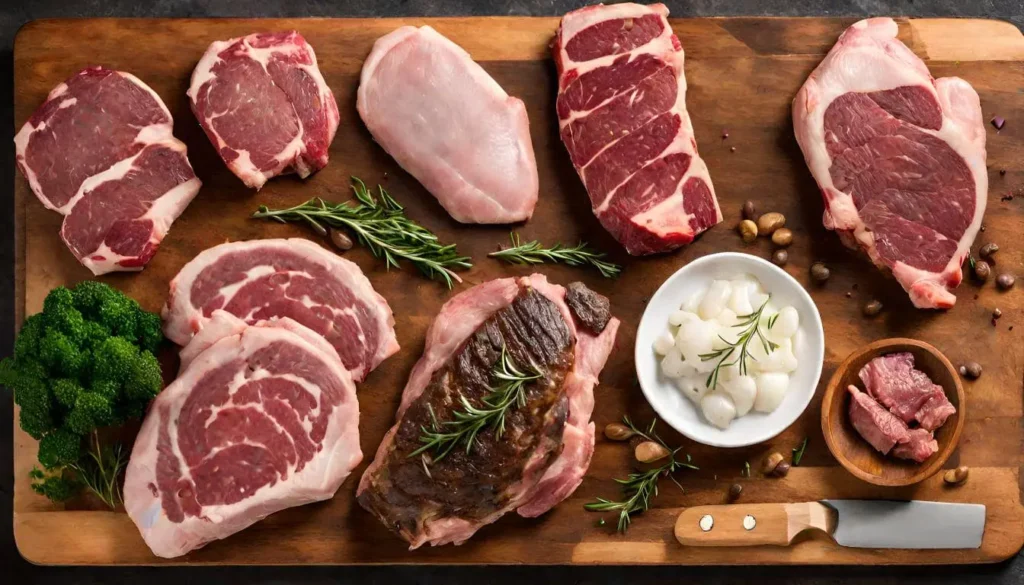Introduction to the Carnivore Diet
Overview of the Carnivore Diet
The Carnivore Diet strictly involves animal products like meat, fish, eggs, and some dairy, while completely avoiding plant-based foods. It’s touted for potential health benefits such as weight loss and better energy. However, the diet’s exclusion of traditional nutrient sources like fruits and vegetables sparks debates.
Popularity and Controversy
The diet’s growing popularity contrasts with concerns about its long-term health implications. Critics often highlight the risks associated with high red meat and saturated fat intake and the lack of plant-based nutrients.
Purpose of the Article
This piece focuses on the role of fried meat in the Carnivore Diet. It examines suitable meat types, explores cooking methods, and assesses the nutritional impact of fried meats within this diet. The aim is to offer a comprehensive view, aiding informed decisions for those considering this diet.
Understanding the Carnivore Diet
What is the Carnivore Diet?
At its essence, the Carnivore Diet involves exclusively consuming animal products. This approach is a significant shift from balanced diets that include a variety of foods like fruits, vegetables, grains, and meats. Instead, it focuses on meats, fish, eggs, and some dairy products, while entirely omitting plant-based foods. Advocates of this diet argue that it mirrors the dietary habits of our ancestors. Furthermore, it takes the low-carb, high-fat principles of the ketogenic diet to an extreme by eliminating all carbohydrates.
Key Principles
Central to the Carnivore Diet are several guiding principles. Firstly, it adopts a zero-carb philosophy, excluding fruits, vegetables, grains, nuts, and seeds. Secondly, the diet favors high-fat meats over lean options, emphasizing the satiety and energy derived from fats. Lastly, it advocates for a nose-to-tail consumption pattern, ensuring the intake of various nutrients found in organ meats and bone marrow, not just muscle meats.
Benefits and Criticisms
On one hand, the Carnivore Diet offers potential benefits. For instance, adherents often report weight loss, improved digestion, decreased inflammation, and a simplified approach to eating. Some even claim relief from autoimmune conditions and enhanced mental clarity. However, it’s important to note that these benefits largely come from individual anecdotes rather than comprehensive scientific research.
Conversely, the diet faces significant criticisms. Health experts express concerns about the absence of dietary fiber and essential nutrients typically found in plant-based foods. Additionally, the high intake of saturated fats raises questions about cardiovascular health. Moreover, the restrictive nature of the diet may lead to monotony in food choices and complications in social eating settings. As a result, many in the health community caution against the unknown long-term impacts of such a restrictive dietary approach.
Can You Eat Fried Meat on the Carnivore Diet?
The Role of Meat in the Carnivore Diet
In the Carnivore Diet, meat is not just a component; it’s the cornerstone. This diet revolves around consuming animal products exclusively, with a significant emphasis on meat due to its high protein and fat content. Different types of meats, from beef to poultry and fish, offer a variety of nutrients essential for the body. For instance, red meat is rich in iron and B vitamins, while fish provides omega-3 fatty acids. The diet encourages consuming meat in its most natural form, favoring grass-fed and pasture-raised options. This emphasis on meat quality aligns with the diet’s goal of maximizing nutrient intake and adhering to what proponents believe to be a more natural, ancestral way of eating.
Types of Cooking Methods Allowed
When following the Carnivore Diet, the cooking methods you choose can significantly impact the nutritional value of the meat. The diet allows various cooking techniques, each with its own set of benefits. These methods include pan-frying, deep-fat frying, and grilling. Each method alters the flavor and texture of the meat, providing variety within the diet’s restrictive nature.
Pan-frying
Pan-frying is a popular method in the Carnivore Diet for its simplicity and ability to create a flavorful crust on meats. It’s ideal for tender cuts with minimal connective tissues, like sirloin and rib-eye steaks. This method ensures the meat is safe to eat, with the outside cooked and the inside remaining rare or medium-rare, which some believe improves digestion.
Deep-fat Frying
While not as common in the Carnivore Diet community, deep-fat frying is another option. This method involves cooking meat submerged in hot fat, typically animal fat to align with the diet’s principles. Deep-fried meats like steaks and chicken wings offer enhanced flavors and a crispy exterior. However, this method is often considered less healthy due to the high temperatures involved and the potential formation of harmful compounds.
Grilling
Grilling is another favored method for cooking meat on the Carnivore Diet. It uses direct, high heat to cook the meat, creating distinct flavors due to the Maillard reaction. Grilling is suitable for fatty and tender cuts like ribeyes and strip steaks. While grilling is quick and efficient, like other high-heat methods, it can result in the formation of harmful chemicals.
Nutritional Considerations of Fried Meat
Fried meat, whether pan-fried or deep-fried, offers distinct flavors and textures that can be appealing on the Carnivore Diet. However, it’s essential to consider the nutritional implications. Frying can add additional fat to the diet, which may be beneficial for those seeking high-fat intake. However, it’s crucial to be mindful of the type of fat used for frying, as some fats can oxidize at high temperatures, potentially leading to health risks. Additionally, the high heat of frying can produce advanced glycation end products (AGEs), which have been linked to inflammation and chronic diseases. Thus, while fried meat can be a part of the Carnivore Diet, it should be consumed in moderation, with attention to the type of fat used and the cooking temperature.
Food Choices on the Carnivore Diet
Permissible Foods
The Carnivore Diet strictly includes animal-based products, focusing on a range of meats, seafood, select dairy items, and eggs. This high protein, high-fat diet often favors grass-fed and pasture-raised meats for their superior nutrient content. Organ meats also play a crucial role due to their dense nutritional value, offering a plethora of vitamins and minerals not present in muscle meats.
Beef
Beef serves as a cornerstone of the Carnivore Diet, providing essential protein and fats. Popular choices like ribeye, sirloin, and brisket offer varying flavors and nutrient profiles. Beef is also a key source of iron and B vitamins, vital for health and energy.
Seafood
Incorporating seafood adds essential variety and nutrients. Fatty fish such as salmon are rich in omega-3 fatty acids, crucial for heart and brain health. Other seafood like shellfish contributes additional proteins and minerals, enhancing the diet’s nutritional balance.
Organ Meats
Organ meats like liver and kidneys are highly recommended for their nutrient richness. They are packed with vitamins A, D, E, and K and minerals like iron and zinc, providing numerous health benefits.
Foods to Avoid
The Carnivore Diet excludes all plant-based foods and certain animal-derived products that don’t fit its guidelines.
Honey
Honey, despite being an animal product, is off-limits due to its high sugar content, which contradicts the diet’s zero-carb rule.
Hot Dogs
While meat-based, hot dogs often contain additives and preservatives, making them less suitable for this diet.
Mayo
Mayonnaise, typically made with vegetable oils and additives, doesn’t fit the Carnivore Diet’s criteria due to its non-animal ingredients and potential carbs.
Special Considerations: Dairy, Processed Meats, etc.
Dairy products are acceptable but should be high in fat and low in carbs, like cheese and butter. However, many dairy products contain additives and sugars, posing a challenge. Processed meats also require careful selection. While they are derived from meat, many processed meats include non-animal ingredients and high sodium levels, conflicting with the diet’s principles. The Carnivore Diet encourages eating the purest forms of animal products, in line with its high-fat, zero-carb, and nutrient-dense philosophy.
Health Implications
Risks and Precautions
The Carnivore Diet, while offering potential benefits, also comes with risks that one must carefully consider. The most notable risk is the diet’s high concentration of saturated fats, which raises concerns about cardiovascular health, particularly in individuals with a predisposition to heart diseases. Another risk involves the lack of dietary fiber, which is crucial for digestive health. This absence can lead to issues like constipation and long-term gut health problems.
Moreover, the elimination of entire food groups can result in nutritional deficiencies. For instance, the lack of fruits and vegetables could lead to a shortage of certain vitamins and antioxidants that are essential for overall health. Experts also caution about the potential increase in LDL cholesterol (the ‘bad’ cholesterol) and the associated risks of heart disease. Therefore, it’s crucial for anyone considering this diet to consult with healthcare professionals, monitor their health regularly, and be aware of the possible long-term health implications.
Managing Nutritional Deficiencies
Addressing potential nutritional deficiencies is a key concern for those on the Carnivore Diet. Since the diet excludes fruits, vegetables, and grains, it can lack certain vitamins, minerals, and fiber. To mitigate these deficiencies, proponents suggest focusing on a variety of meats, including organ meats like liver, which are rich in nutrients like Vitamin A, Vitamin B12, and iron. Additionally, incorporating seafood can provide essential nutrients like omega-3 fatty acids and iodine. It’s important for individuals to monitor their health and consider supplements for nutrients that are hard to obtain solely from animal products, such as Vitamin C and fiber. Regular medical check-ups and blood tests can help in tracking and managing any nutritional gaps.
Personal Stories and Medical Opinions
Personal experiences with the Carnivore Diet vary widely, with some individuals reporting significant health improvements and others facing challenges. Anecdotal reports often mention benefits like weight loss, improved energy levels, and relief from autoimmune conditions. However, medical professionals and nutrition experts tend to approach these claims with caution. They emphasize the lack of comprehensive research on the long-term effects of the diet and highlight the potential risks associated with such a restrictive eating pattern. It’s important to recognize that individual experiences may not be universally applicable and that thorough scientific studies are needed to fully understand the impacts of the Carnivore Diet on health.
FAQs
Addressing Common Questions and Misconceptions
Can I only eat red meat on the Carnivore Diet?
No, the Carnivore Diet isn’t limited to just red meat. It includes a variety of animal products like poultry, fish, eggs, and certain dairy products. The key is focusing on animal-based foods and avoiding plant-based foods.
Is it necessary to eat organ meats on this diet?
While not mandatory, including organ meats is highly recommended due to their nutrient density. Organ meats, like liver and kidneys, are rich in vitamins and minerals that might be lacking in muscle meats.
How do I get enough fiber without eating plants?
The Carnivore Diet challenges the traditional view that dietary fiber is essential for digestive health. Proponents claim that the reduced residue from digesting animal products lessens the need for fiber. However, it’s crucial to monitor digestive health, as individual responses to a low-fiber diet can vary.
Can I drink coffee or tea on the Carnivore Diet?
Strictly speaking, coffee and tea are plant derivatives and not part of the Carnivore Diet. However, some individuals following this diet choose to include them in moderation, based on personal preference and tolerance.
Will I get enough vitamins and minerals without fruits and vegetables?
The Carnivore Diet relies on animal products to provide essential nutrients. Organ meats and seafood are particularly nutrient-dense. Nonetheless, there may be a risk of deficiencies in certain vitamins and minerals found abundantly in plant foods, which is why some individuals on this diet opt for targeted supplementation.
Is the Carnivore Diet safe for long-term adherence?
The long-term safety of the Carnivore Diet is still a subject of debate among health professionals. While some individuals report significant health improvements, experts caution about potential nutritional deficiencies and other health risks. It’s important to consult healthcare providers and consider regular health monitoring if following this diet long-term.
Conclusion
The Carnivore Diet, centering solely on animal-based foods, has sparked interest and debate in the nutritional world. It promotes eating meats, fish, eggs, and specific dairy products while excluding all plant-based foods. The diet’s highlights include its emphasis on high-fat, high-protein intake and the inclusion of nutrient-rich organ meats. However, it faces criticism for potential health risks like nutritional deficiencies and increased saturated fat intake. Personal experiences vary, with some reporting significant health benefits and others encountering challenges.
When considering the Carnivore Diet, it’s crucial to weigh its potential benefits against the possible health risks. This diet may offer a simplified eating approach and anecdotal health improvements, but it also requires careful consideration of nutritional balance and long-term health implications. Consulting healthcare professionals, regular health monitoring, and possibly supplementing essential nutrients missing from the diet are prudent steps. As with any diet, individual responses vary, and what works for one person may not be suitable for another. Ultimately, informed choice and personal health considerations should guide dietary decisions.








